1.射频无线 通信系统介绍
无线通信与射频电路仿真

定向性与增益
控制天线发射和接收信号 的方向性,以及增强信号 的强度。
阻抗匹配
确保天线输出的阻抗与发 射机或接收机的输入阻抗 相匹配,以实现高效的能 量传输。
CHAPTER
04
无线通信系统仿真
仿真工具介绍
电磁仿真软件
如Ansys HFSS、CST等,用于模拟电磁波传播、天 线性能等。
通信系统仿真软件
灵敏度
灵敏度是指射频电路在接收信号时的最低可 检测信号强度。
动态范围
动态范围是指射频电路能够处理的信号强度 的最大值和最小值之比。
线性度
线性度是指射频电路在处理信号时保持线性 关系的程度。
射频电路的设计流程
原理图设计
根据系统分析结果,设计射频 电路的原理图。
版图设计
根据仿真结果,进行版图设计 ,准备制版。
降低成本
减少实物制作和测试的成本,缩短开发周期 。
CHAPTER
06
无线通信与射频电路仿真的未 来发展
5G/6G通信技术的影响
5G/6G通信技术将带来更高的数据传 输速率、更低的延迟和更广泛的网络 覆盖,对无线通信与射频电路仿真提 出了更高的要求。
5G/6G通信技术将促进物联网、边缘 计算等技术的发展,使得无线通信系 统更加复杂,需要更精确的仿真来预 测系统的性能和优化设计。
系统级仿真软件
如MATLAB、Simulink等,用于 模拟无线通信系统性能、信号处 理算法实现等。
仿真流程与方法
建立数学模型
根据物理原理和电路设计,建立 相应的数学模型。
选择合适的仿真软件
根据仿真目标和参数选择合适的 仿真软件。
进行仿真实验
设置实验条件,进行仿真实验并 记录数据。
无线射频技术介绍

无线射频技术介绍无线射频技术介绍初识无线射频技术我们先来看官方的说法。
无线射频技术是一种近距离、低复杂度、低功耗、低数据速率、低成本的无线通信技术。
这种技术的优点是部分产品无需重新布线,利用点对点的射频技术,实现对家电和灯光的控制,安装设置都比较方便,主要应用于实现对某些特定电器或灯光的控制,成本适中。
这类系统功能比较弱,控制方式比较单一,且易受周围无线设备环境特别是同频及阻碍物干扰和屏蔽;较适用于新装修户和已装修户。
这也就是我们家庭网络中所提到的有线网络和无线网络的区别。
无线网络技术在没有布线的情况下也可以搭建家庭局域网。
而无线射频技术也就是通过高频的无线频率(315或433.92 MHz)点对点传输,实现灯光、窗帘、家电等的遥控功能。
这类技术对于已经装修好了的用户非常适用,无须预先布线,不会破坏原有家居的美观。
使用基于无线射频技术的产品,就可以将家里所有的电器串成一个网络,我们这里称它为智能家居无线网络,在这个网络中,我们可以随意遥控,让每个冷冰冰的电器都听命于我们。
目前,国内使用无线射频技术的厂家有波创、清华同方、百通以及西格等。
如何让家电听命于我们?家里的电器设备很多,灯光、冰箱、空调、电脑、家庭影院……有些属于本身就带有遥控能力的,比如空调、电视机……有些是不具备遥控功能的,比如热水器、微波炉、电饭煲、冰箱……而不同的遥控设备又带有不同的遥控器,相互间又不能通用,于是家里光遥控器就有四五个。
那么如何遥控不具备遥控功能的设备?以及如何让一个遥控器实现多个遥控器的功能呢?从上面的介绍我们知道,基于无线射频技术的产品是能帮我们解决这些问题的,但他们是如何实现的呢?智能家居无线网络主要包括了一个家庭网关以及若干个无线通讯子节点。
在家庭网关上有一个无线发射模块,每个子节点上都接有一个无线网络接收模块,通过这些无线网络收发模块,数据就在网关和子节点之间进行传送。
1.家庭网关家庭智能网关就是家庭的一个智能化控制中心,带有嵌入式处理器和Arm linux操作系统;具有可触摸的TFT液晶显示屏(5~10英寸);有14路报警点输入和2路报警控制输出,发生警情时可通过网络或电话报警;通过网关上的无线射频模块与网络中各子节点进行通讯,实现家电控制;内置了Web server,通过Web方式实现家电的远程控制。
射频系统的组成

射频系统的组成射频系统是指由射频信号源、射频调制器、射频放大器、射频滤波器、射频混频器、射频解调器等多个组件组成的系统。
它在无线通信、雷达、卫星通信等领域中起着重要的作用。
下面将对射频系统的每个组成部分进行详细介绍。
1. 射频信号源射频信号源是射频系统中最基本的组成部分之一,它负责产生射频信号。
射频信号源可以是一个固定频率的振荡器,也可以是可调频率的振荡器。
射频信号源的频率决定了射频系统的工作频率。
2. 射频调制器射频调制器将基带信号转换为射频信号。
它通过改变射频信号的幅度、相位或频率等参数,将基带信号的信息传输到射频信号中。
射频调制器通常采用调制电路、混频器等组件来实现。
3. 射频放大器射频放大器用于放大射频信号的幅度。
它能够将射频信号的功率增加到一定的水平,以便在传输过程中能够有效地传输信号。
射频放大器通常采用晶体管、功率放大器等元件来实现。
4. 射频滤波器射频滤波器用于过滤射频信号。
它能够去除射频信号中的杂散信号和干扰信号,使得信号质量得到提高。
射频滤波器通常采用电容、电感等元件来实现。
5. 射频混频器射频混频器用于将两个或多个射频信号进行混合。
它能够将频率较高的射频信号和频率较低的本地振荡器信号进行混合,从而得到中频信号。
射频混频器通常采用二极管、集成电路等元件来实现。
6. 射频解调器射频解调器用于将射频信号转换为基带信号。
它能够将射频信号中的调制信息提取出来,并恢复为原始的基带信号。
射频解调器通常采用解调电路、滤波器等组件来实现。
以上是射频系统的主要组成部分。
除了这些组件外,射频系统还可能包括射频开关、射频功率检测器、射频保护器等其他辅助组件。
这些组件共同协作,使得射频系统能够完成信号的传输、调制、放大、滤波等功能。
射频系统在无线通信、雷达、卫星通信等领域中的应用广泛。
它可以实现无线信号的传输和接收,使得人们可以在无线环境中进行通信。
同时,射频系统还可以用于雷达系统中的目标探测和跟踪,以及卫星通信中的信号传输等。
基带射频详细作用

基带射频详细作用基带(Baseband)是指无线通信系统中负责数字信号处理的部分,射频(RF)是指无线通信中的无线电频率信号。
基带和射频在无线通信中起着不同的作用,下面将详细介绍它们的功能。
基带的作用:1.数字信号处理:基带负责对数字信号进行处理。
在无线通信系统中,数字信号首先被调制为基带信号,然后经过一系列的编码、解码、调制、解调等操作,最终转换为无线电频率信号发送出去。
基带负责对信号进行数字化处理,包括对信号进行采样、量化、编码等操作,使其能够适应无线传输的特性。
2.调制/解调:基带负责对信号进行调制和解调。
调制是将数字信号转换为模拟信号的过程,其中包括将数字信号与载波信号相乘,形成调制信号。
解调是将接收到的调制信号还原为原始的数字信号的过程,其中包括将调制信号与载波信号相乘,去除调制信号中的载波信号,从而得到原始的数字信号。
3.编码/解码:基带负责对信号进行编码和解码。
编码是将数字信号转换为更适合传输的形式,以提高抗干扰性和容错性。
解码则是将接收到的编码信号还原为原始的数字信号。
编码和解码的方式有很多种,如准整流编码、差分编码、卷积编码等。
4.信号处理:基带负责对信号进行数字信号处理。
信号处理包括了对信号进行滤波、降噪、增强等操作,以提高信号的质量和可靠性。
其中滤波是信号处理中的重要环节,通过滤波可以去除信号中的噪声和干扰,提高信号的纯净度。
射频的作用:1.射频调制/解调:射频负责对信号进行射频调制和解调。
射频调制是将基带信号转换为射频信号的过程,其中包括将基带信号与射频载波信号相乘,形成调制后的射频信号。
射频解调则是将接收到的射频信号还原为基带信号。
射频调制和解调是无线通信系统中的一个重要环节。
2.发射和接收:射频负责无线通信中的发射和接收。
在发射端,射频负责将调制后的信号转换为射频信号,并将其通过天线发射出去。
在接收端,射频负责接收来自天线的射频信号,然后将其转换为基带信号,供接下来的数字信号处理。
射频技术的原理和应用
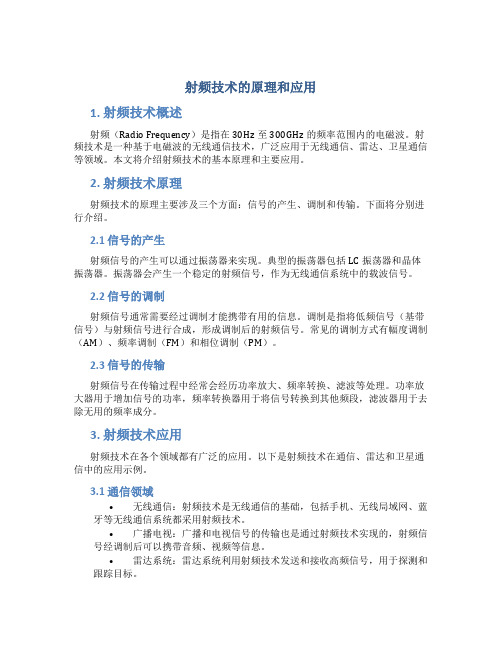
射频技术的原理和应用1. 射频技术概述射频(Radio Frequency)是指在30Hz至300GHz的频率范围内的电磁波。
射频技术是一种基于电磁波的无线通信技术,广泛应用于无线通信、雷达、卫星通信等领域。
本文将介绍射频技术的基本原理和主要应用。
2. 射频技术原理射频技术的原理主要涉及三个方面:信号的产生、调制和传输。
下面将分别进行介绍。
2.1 信号的产生射频信号的产生可以通过振荡器来实现。
典型的振荡器包括LC振荡器和晶体振荡器。
振荡器会产生一个稳定的射频信号,作为无线通信系统中的载波信号。
2.2 信号的调制射频信号通常需要经过调制才能携带有用的信息。
调制是指将低频信号(基带信号)与射频信号进行合成,形成调制后的射频信号。
常见的调制方式有幅度调制(AM)、频率调制(FM)和相位调制(PM)。
2.3 信号的传输射频信号在传输过程中经常会经历功率放大、频率转换、滤波等处理。
功率放大器用于增加信号的功率,频率转换器用于将信号转换到其他频段,滤波器用于去除无用的频率成分。
3. 射频技术应用射频技术在各个领域都有广泛的应用。
以下是射频技术在通信、雷达和卫星通信中的应用示例。
3.1 通信领域•无线通信:射频技术是无线通信的基础,包括手机、无线局域网、蓝牙等无线通信系统都采用射频技术。
•广播电视:广播和电视信号的传输也是通过射频技术实现的,射频信号经调制后可以携带音频、视频等信息。
•雷达系统:雷达系统利用射频技术发送和接收高频信号,用于探测和跟踪目标。
3.2 雷达领域•航空雷达:航空雷达用于飞机导航和气象监测,通过接收和解析射频信号的回波,可以确定目标的位置和特征。
•雷达警报系统:射频技术可以用于开发雷达警报系统,用于监测可能的目标入侵或异常情况。
•科学研究:射频技术在天文学、地质学等科学研究中也有广泛应用,用于探测宇宙、地球的信号和数据。
3.3 卫星通信•卫星通信系统:卫星通信系统通过射频信号实现地面与卫星之间的通信,包括广播、电话、互联网等应用。
通信设备的射频和天线原理

通信设备的射频和天线原理射频(Radio Frequency)是指在无线电通信中使用的频率范围,常用于无线电广播、移动通信和卫星通信等领域。
而天线则是将射频信号转换为电磁波并发送或接收的装置。
本文将详细介绍通信设备的射频和天线原理,包括射频信号的特性、天线的种类和工作原理、以及射频和天线在通信设备中的应用等。
一、射频信号的特性1. 频率范围:射频信号通常指100 kHz到100 GHz范围内的电磁波信号。
2. 调制方式:射频信号可以通过调幅、调频、调相等方式进行信息传输。
3. 传输特性:射频信号在空气中传播时会受到衰减、散射等影响,传输距离有限,因此需要配备天线进行发送和接收。
二、天线的种类和工作原理1. 高频天线:适用于频率在3 MHz至30 GHz范围内的通信,包括折射天线、微带天线等。
2. 超高频天线:适用于频率在300 MHz至3 GHz范围内的通信,包括对数周期天线、塔罗天线等。
3. 毫米波天线:适用于频率在30 GHz至300 GHz范围内的通信,包括方向性缝隙天线、平板天线等。
4. 天线原理:天线通常由导体材料制成,其工作原理基于电磁场的辐射和接收。
发送信号时,电流在天线上产生电磁场,将电信号转换为电磁波并发送出去;接收信号时,电磁波会激励天线上的电流,将电磁波转换为电信号并传输给接收设备。
三、射频和天线在通信设备中的应用1. 无线通信:手机、无线局域网、蓝牙等无线通信设备都需要使用射频和天线来发送和接收信号。
2. 卫星通信:卫星通信系统中的卫星和地面站都需要使用天线进行信号的发送和接收。
3. 电视和广播:电视和广播信号的传输和接收都离不开天线,并且需要根据信号的频率范围选择合适的天线。
4. 导航系统:GPS、北斗等卫星导航系统都需要使用射频和天线来接收导航信号。
5. 雷达系统:雷达系统通过射频和天线发射和接收电磁波来进行目标探测和跟踪。
以上就是通信设备的射频和天线原理的详细内容和步骤。
射频面试基本知识
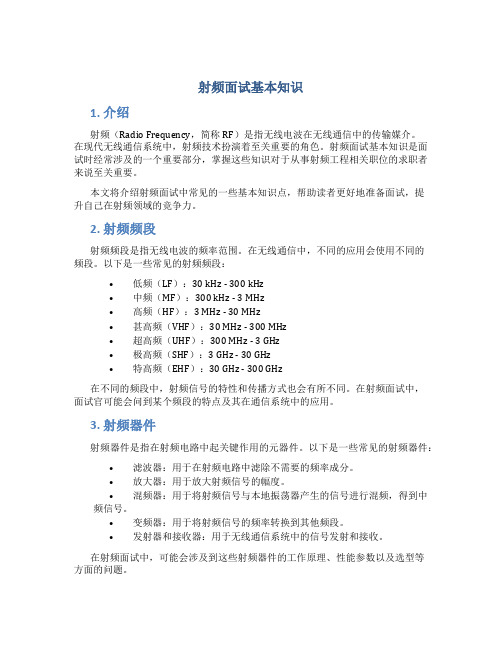
射频面试基本知识1. 介绍射频(Radio Frequency,简称RF)是指无线电波在无线通信中的传输媒介。
在现代无线通信系统中,射频技术扮演着至关重要的角色。
射频面试基本知识是面试时经常涉及的一个重要部分,掌握这些知识对于从事射频工程相关职位的求职者来说至关重要。
本文将介绍射频面试中常见的一些基本知识点,帮助读者更好地准备面试,提升自己在射频领域的竞争力。
2. 射频频段射频频段是指无线电波的频率范围。
在无线通信中,不同的应用会使用不同的频段。
以下是一些常见的射频频段:•低频(LF):30 kHz - 300 kHz•中频(MF):300 kHz - 3 MHz•高频(HF):3 MHz - 30 MHz•甚高频(VHF):30 MHz - 300 MHz•超高频(UHF):300 MHz - 3 GHz•极高频(SHF):3 GHz - 30 GHz•特高频(EHF):30 GHz - 300 GHz在不同的频段中,射频信号的特性和传播方式也会有所不同。
在射频面试中,面试官可能会问到某个频段的特点及其在通信系统中的应用。
3. 射频器件射频器件是指在射频电路中起关键作用的元器件。
以下是一些常见的射频器件:•滤波器:用于在射频电路中滤除不需要的频率成分。
•放大器:用于放大射频信号的幅度。
•混频器:用于将射频信号与本地振荡器产生的信号进行混频,得到中频信号。
•变频器:用于将射频信号的频率转换到其他频段。
•发射器和接收器:用于无线通信系统中的信号发射和接收。
在射频面试中,可能会涉及到这些射频器件的工作原理、性能参数以及选型等方面的问题。
4. 射频传输线射频传输线是指在射频电路中用于传输射频信号的导线或导轨。
常见的射频传输线有以下几种:•同轴电缆:由内导体、绝缘层、外导体和外护套组成,适用于高频和宽带信号的传输。
•微带线:由金属线和绝缘基板组成,适用于高频和微波信号的传输。
•波导:由金属管道或金属壳体组成,适用于超高频和毫米波信号的传输。
rfs知识点总结

rfs知识点总结RFS (Radio Frequency System)是一个广泛应用在通信领域的系统,涉及到射频信号的发送、接收、调制和解调等一系列过程。
它在无线通信、雷达检测、卫星通信等领域都有着重要的应用。
本文将从RFS的基本原理、应用领域、关键技术等方面进行总结和介绍。
一、RFS的基本原理1. 射频信号和频率射频信号是指频率在300Hz到300GHz之间的电磁波信号。
在无线通信中,通常会用频率来区分不同的信号。
频率越高,信号的传输速度越快,但是穿透力会相对较弱。
2. 数据调制与解调在RFS中,数据调制是指将数字信号转换成模拟信号,而解调则是将模拟信号转换成数字信号。
调制方式有幅度调制、频率调制和相位调制等,而解调则是对应的反向过程。
3. 天线和传输线天线是用来发送和接收射频信号的装置,具有辐射和接收的功能。
传输线是指用来传输射频信号的导线,例如同轴电缆、微带传输线等。
4. 信号解耦信号解耦是指将多个信号分离开来,使其不相互影响。
在RFS系统中,信号解耦可以有效地提高信号的传输质量。
5. 频谱分配频谱分配是指将整个频谱范围划分成多个小的频段,以便多个通信系统之间不会相互干扰。
这在无线通信系统中是十分重要的。
二、RFS的应用领域1. 无线通信RFS在无线通信领域有着广泛的应用,包括移动通信、卫星通信、无线局域网等。
通过RFS系统,用户可以实现无线语音通话、数据传输等功能。
2. 雷达检测雷达是一种利用电磁波进行目标检测的设备,而它的核心就是RFS系统。
雷达可以实现目标探测、跟踪、成像等功能,广泛应用于军事、气象、航空等领域。
3. 卫星通信卫星通信是指通过人造卫星进行通信的方式,它可以实现全球范围内的通信覆盖。
RFS系统在卫星通信中扮演着核心角色,它负责卫星信号的发送、接收、处理等一系列过程。
4. 电子对抗电子对抗是指通过电磁手段来干扰敌方通信或雷达设备的行为。
RFS系统在电子对抗中扮演着重要的作用,它可以实现信号拦截、干扰、伪装等功能。
第1章无线通信中射频收发机结构及应用1

无线局域网(WLAN)是利用全球通用且无须申请许可的ISM频段 (2.4GHz频段、5.0GHz频段),在无线的环境中实现便携式移动通 信。
2020/5/12
25
1.5 典型应用的集成收发信机
1.5.2 应用于无线局域网的收发机
无线局域网(WLAN)是利用全球通用且无须申请许可的ISM频段 (2.4GHz频段、5.0GHz频段),在无线的环境中实现便携式移动通 信。
2020/5/12
18
1.3 射频电路与微波电路和低频电路的关系
IEEE和工业用微波波段的定义
频带名称 L带 C带 Ku带
Ka带(毫米波) U带(毫米波) E带(毫米波) F带(毫米波)
频率范围(GHz) 1.0~2.0 4.0~8.0
12.0~18.0 26.5~40.0 40.0~60.0 60.0~90.0 90.0~140.0
2020/5/12
7
1.1 无线收发信机射频前端功能和特性
对于发送系统硬件电路系统而言,最困难的部分就在于中放变
频和功放。中放变频的难点主要在于变频系统方案的设计,好
的系统方案设计可能产生的相关干扰较少,甚至还可能降低对
参与变频的本地振荡信号的要求。
基带信号 解调
中频变 频
低噪声放 大器
接收天线
图1-2接收机结构图
2020/5/12
20
2.高射频和微波电路
对于高射频和微波电路,其中可以有一个或几个集总元件,但至 少要有一个分布式元件。
对于分布电路,具有下述三个特点:
1.必须采用麦克斯韦方程提出的波传播概念;
2.电路要有大的电长度,物理长度与电路中信号传播的波长可比拟;
无线通信系统的原理和特点
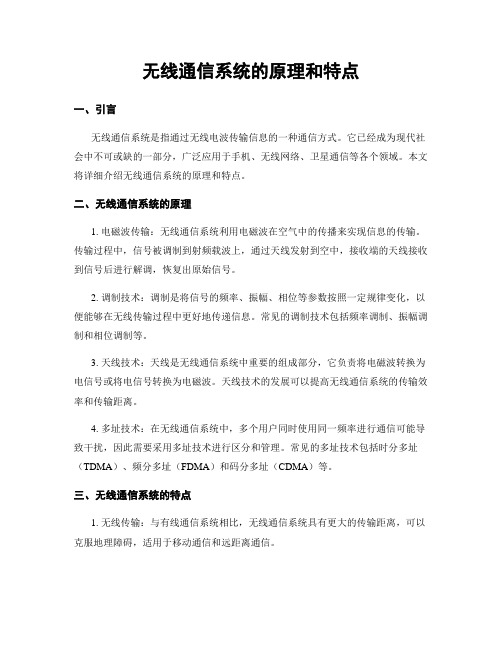
无线通信系统的原理和特点一、引言无线通信系统是指通过无线电波传输信息的一种通信方式。
它已经成为现代社会中不可或缺的一部分,广泛应用于手机、无线网络、卫星通信等各个领域。
本文将详细介绍无线通信系统的原理和特点。
二、无线通信系统的原理1. 电磁波传输:无线通信系统利用电磁波在空气中的传播来实现信息的传输。
传输过程中,信号被调制到射频载波上,通过天线发射到空中,接收端的天线接收到信号后进行解调,恢复出原始信号。
2. 调制技术:调制是将信号的频率、振幅、相位等参数按照一定规律变化,以便能够在无线传输过程中更好地传递信息。
常见的调制技术包括频率调制、振幅调制和相位调制等。
3. 天线技术:天线是无线通信系统中重要的组成部分,它负责将电磁波转换为电信号或将电信号转换为电磁波。
天线技术的发展可以提高无线通信系统的传输效率和传输距离。
4. 多址技术:在无线通信系统中,多个用户同时使用同一频率进行通信可能导致干扰,因此需要采用多址技术进行区分和管理。
常见的多址技术包括时分多址(TDMA)、频分多址(FDMA)和码分多址(CDMA)等。
三、无线通信系统的特点1. 无线传输:与有线通信系统相比,无线通信系统具有更大的传输距离,可以克服地理障碍,适用于移动通信和远距离通信。
2. 移动性:无线通信系统可以实现移动终端的通信需求,如手机、移动电脑等,为人们提供了便利。
3. 高带宽:随着无线通信技术的发展,无线通信系统的带宽越来越大,能够支持更多的用户同时进行高速数据传输。
4. 自动化管理:无线通信系统能够实现自动化管理,通过网络管理系统对网络的配置、优化和故障排除等进行监控和管理,提高了通信的可靠性和稳定性。
5. 安全性:无线通信系统中的信息传输可以通过加密算法进行保护,使得信息更加安全可靠。
四、无线通信系统的应用领域1. 移动通信:无线通信系统是手机通信的基础,通过建立基站实现移动终端之间的通信。
2. 无线网络:无线通信系统在无线局域网(WLAN)和城域网(WMAN)中有广泛的应用,实现了无线上网和无线接入等功能。
射频技术的名词解释

二、射频技术的应用
1.无线通信:射频技术是无线通信的核心。其中,移动通信是射频技术的主要应用之一。通过射频技术,手机可以接收和发送无线信号,实现语音、短信和数据的传输。此外,射频技术还被广泛应用于卫星通信、卫星导航和无线局域网。
2.雷达:雷达是利用射频技术进行目标探测和跟踪的一种技术。射频信号经过发射装置发射出去后,遇到目标物体后会发生散射,散射回来的信号经过接收装置接收并进行处理,从而获得目标的位置、速度等信息。雷达广泛应用于军事、航空、气象等领域。
3.医疗诊断和治疗:射频技术在医疗领域中也有重要作用。例如,射频诊断技术可以通过人体组织对射频信号的不同吸收特性,来检测和诊断疾病。射频治疗技术可以用于癌症治疗、心脑血管疾病治疗等,有效地破坏异常细胞或组织。
射频技术的名词解释
射频技术(Radio Frequency,简称RF),是一种电磁波频率范围在3kHz到300GHz之间的电磁辐射技术。它在现代通信领域中发挥着重要作用,被广泛应用于无线电通信、雷达、导航系统、卫星通信、医疗诊断和治疗等领域。
一、射频技术的基本原理
射频技术利用电磁波在空间中传播的特性进行通信和数据传输。射频信号可以通过天线发送和接收,天线将电信号转化为电磁波信号,然后将其传播到空中。接收端的天线接收到电磁波信号后,将其转化为电信号,通过解调等处理,得到原始的信号信息。
2.小型化和集成化:随着技术的进步,射频器件越来越小型化和集成化。这将有助于将射频技术应用于更多的领域,同时减小设备体积,提高设备的便携性。
GSM系统介绍

GSM系统结构GSM系统由三个分系统组成,即移动台、基站子系统(BSS)、网络子系统(NSS)1.移动台移动台是GSM系统中的用户设备,可以车载型、便携型和手持型。
移动台并非固定于一个用户,在系统中的任何一个移动台都可以利用用户识别卡(SIM 卡)来识别移动用户,保证合法用户使用移动网。
移动台也有自己的识别码,称为国际移动设备识别号(IMEI)。
网络可以对IMEI进行检查,比如关断有故障的移动台或被盗的移动台,检查移动台的型号许可代码等。
GSM移动台不仅能完成传统的电话业务、数字业务,如传输文字、图像、传真等,还能完成短消息业务等非传统的业务。
2.基站子系统(BSS)基站子系统包含了GSM数字移动通信系统的无线通信部分,它一方面通过无线接口直接与移动台连接,完成无线信道的发送、和管理,另一方面连接到网络子系统的交换机。
基站子系统可以分为两部分:一是基站收、发台(BTS),一是基站控制器(BSC)。
BTS 负责无线传输,BSC负责控制和管理。
3.网络子系统(NSS)网络子系统分为六个功能单元,即移动交换中心(MSC)、归属位置寄存器(HLR)、拜访位置寄存器(VLR)、鉴权中心(AUC)、设备识别寄存器(EIR)、操作与维护中心(OMC),现分别介绍:(1)移动交换中心(MSC)MSC是网络核心,它具有交换功能,能使移动用户之间,移动用户与固定用户之间互相连接。
它提供了与其它的MSC互连接口,和与固定网(如PSTN,ISDN等)的接口。
MSC从三种数据库――归属位置寄存器(HLR),拜访位置寄存器(VLR),鉴权中心(AUC)――取得处理用户呼叫请求所需的全部数据,MSC也跟据最新数据更新数据库。
(2)归属位置寄存器(HLR)归属位置寄存器是系统的中央数据库,它存储着归属用户的所有数据,包括用户的接入验证、漫游能力、补充业务等。
另外,HLR还为MSC提供关于移动台实际漫游所在的MSC 区域的信息(动态数据),这样使任何入局呼叫立即按选择的路径送到被呼用户。
射频通信系统方案
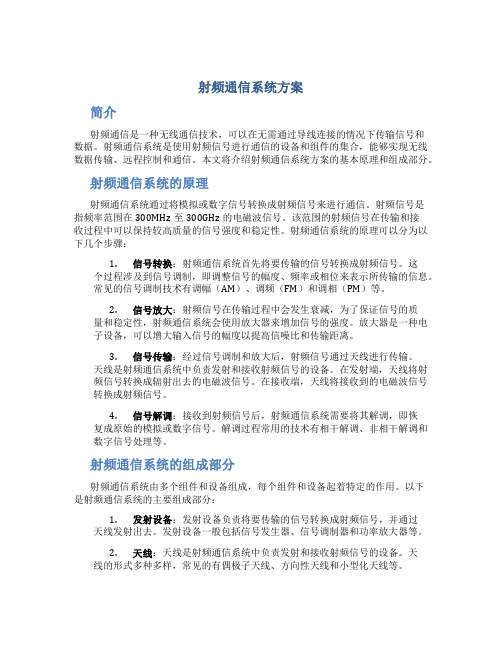
射频通信系统方案简介射频通信是一种无线通信技术,可以在无需通过导线连接的情况下传输信号和数据。
射频通信系统是使用射频信号进行通信的设备和组件的集合,能够实现无线数据传输、远程控制和通信。
本文将介绍射频通信系统方案的基本原理和组成部分。
射频通信系统的原理射频通信系统通过将模拟或数字信号转换成射频信号来进行通信。
射频信号是指频率范围在300MHz至300GHz的电磁波信号。
该范围的射频信号在传输和接收过程中可以保持较高质量的信号强度和稳定性。
射频通信系统的原理可以分为以下几个步骤:1.信号转换:射频通信系统首先将要传输的信号转换成射频信号。
这个过程涉及到信号调制,即调整信号的幅度、频率或相位来表示所传输的信息。
常见的信号调制技术有调幅(AM)、调频(FM)和调相(PM)等。
2.信号放大:射频信号在传输过程中会发生衰减,为了保证信号的质量和稳定性,射频通信系统会使用放大器来增加信号的强度。
放大器是一种电子设备,可以增大输入信号的幅度以提高信噪比和传输距离。
3.信号传输:经过信号调制和放大后,射频信号通过天线进行传输。
天线是射频通信系统中负责发射和接收射频信号的设备。
在发射端,天线将射频信号转换成辐射出去的电磁波信号。
在接收端,天线将接收到的电磁波信号转换成射频信号。
4.信号解调:接收到射频信号后,射频通信系统需要将其解调,即恢复成原始的模拟或数字信号。
解调过程常用的技术有相干解调、非相干解调和数字信号处理等。
射频通信系统的组成部分射频通信系统由多个组件和设备组成,每个组件和设备起着特定的作用。
以下是射频通信系统的主要组成部分:1.发射设备:发射设备负责将要传输的信号转换成射频信号,并通过天线发射出去。
发射设备一般包括信号发生器、信号调制器和功率放大器等。
2.天线:天线是射频通信系统中负责发射和接收射频信号的设备。
天线的形式多种多样,常见的有偶极子天线、方向性天线和小型化天线等。
3.传输介质:射频信号在传输过程中需要通过一种介质来传输,常见的传输介质有自由空间、电缆、微带线和光纤等。
无线收发器设计指南:现代无线设备与系统篇_记录

《无线收发器设计指南:现代无线设备与系统篇》读书札记目录一、无线收发器基础概念 (2)1.1 无线通信原理简介 (3)1.2 无线收发器的功能与分类 (4)1.3 现代无线收发器的发展趋势 (5)二、无线收发器设计要素 (6)2.1 无线收发器的硬件设计 (8)2.1.1 射频前端设计 (9)2.1.2 模数转换器 (10)2.1.3 数模转换器 (12)2.1.4 天线与射频模块 (13)2.1.5 电源管理与稳压电路 (14)2.2 无线收发器的软件设计 (15)2.2.1 微控制器与嵌入式系统 (16)2.2.2 通信协议与数据处理算法 (17)2.2.3 驱动程序与固件开发 (19)2.3 无线收发器的系统设计与布局 (20)2.3.1 系统架构设计 (22)2.3.2 PCB布局与布线 (23)2.3.3 散热与电磁兼容性设计 (25)三、无线收发器应用案例分析 (26)3.1 无线传感器网络 (27)3.2 蓝牙技术 (29)四、无线收发器设计挑战与解决方案 (30)4.1 信号干扰与抑制技术 (31)4.2 无线收发器的能效优化 (32)4.3 多频段与多标准支持 (34)4.4 安全性与可靠性问题 (35)五、未来展望与建议 (37)5.1 无线收发器技术的未来发展方向 (38)5.2 对无线收发器设计的建议与展望 (40)一、无线收发器基础概念在深入探讨无线收发器的设计与应用之前,我们首先需要明确其基础概念。
无线收发器,作为无线通信的核心组件,它不仅实现了信号的发送与接收,更承载着数据传输的关键任务。
传统的无线收发器常采用分立元件或集成电路来实现信号的调制与解调。
这些技术虽然成熟稳定,但在集成度、功耗和成本等方面存在一定的局限性。
随着技术的不断进步,单片无线收发器应运而生,它集成了多种功能,包括天线、放大器、调制解调器等,大大简化了系统的设计与实现过程。
无线收发器的设计也充分考虑了通信协议的要求,不同的无线标准(如WiFi、蓝牙、ZigBee等)对信号传输的速率、带宽、功耗等参数有着不同的定义。
无线射频基础知识介绍
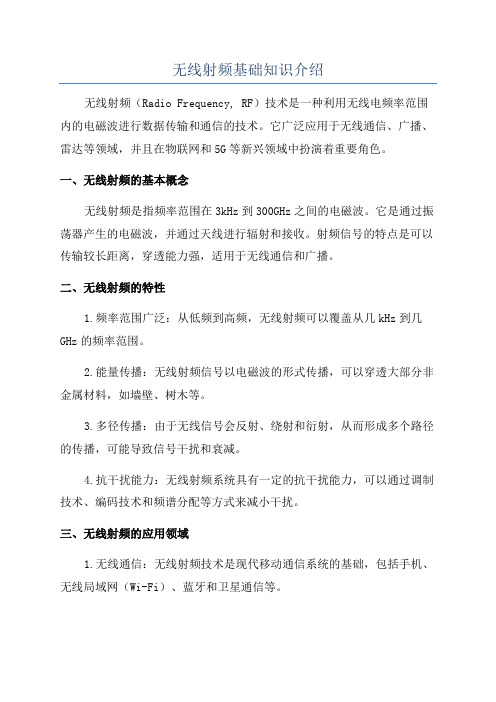
无线射频基础知识介绍无线射频(Radio Frequency, RF)技术是一种利用无线电频率范围内的电磁波进行数据传输和通信的技术。
它广泛应用于无线通信、广播、雷达等领域,并且在物联网和5G等新兴领域中扮演着重要角色。
一、无线射频的基本概念无线射频是指频率范围在3kHz到300GHz之间的电磁波。
它是通过振荡器产生的电磁波,并通过天线进行辐射和接收。
射频信号的特点是可以传输较长距离,穿透能力强,适用于无线通信和广播。
二、无线射频的特性1.频率范围广泛:从低频到高频,无线射频可以覆盖从几kHz到几GHz的频率范围。
2.能量传播:无线射频信号以电磁波的形式传播,可以穿透大部分非金属材料,如墙壁、树木等。
3.多径传播:由于无线信号会反射、绕射和衍射,从而形成多个路径的传播,可能导致信号干扰和衰减。
4.抗干扰能力:无线射频系统具有一定的抗干扰能力,可以通过调制技术、编码技术和频谱分配等方式来减小干扰。
三、无线射频的应用领域1.无线通信:无线射频技术是现代移动通信系统的基础,包括手机、无线局域网(Wi-Fi)、蓝牙和卫星通信等。
2.广播:广播电台利用无线射频技术传输音频信号,实现广播节目的传播。
3.雷达:雷达系统利用射频信号来探测目标的位置、速度和距离,广泛应用于军事和民用领域。
5.定位和导航:利用无线射频信号和三角测量原理,可以实现定位和导航功能,如GPS系统。
6.医疗:医疗设备中的无线射频技术可以用于监测患者的生命体征、无线手术和无线成像等。
7.物联网:物联网系统中的无线射频技术实现物体之间的无线连接和通信,促进设备之间的互联互通。
四、无线射频的未来发展随着科技的不断进步,无线射频技术也在不断发展。
未来,无线射频技术可能会有以下趋势:1.5G技术的推广:5G技术将提供更高的速度和更低的延迟能力,将推动无线通信技术的进一步发展和应用。
2.物联网应用的普及:物联网将实现设备之间的互联互通,无线射频技术在物联网中将发挥更加重要的作用。
射频通信原理
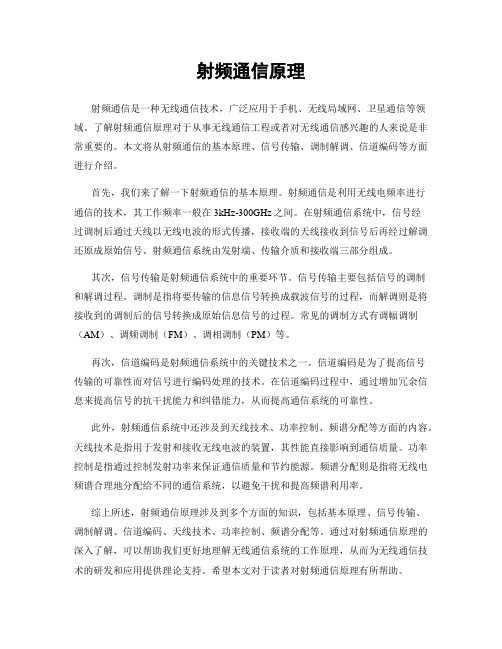
射频通信原理射频通信是一种无线通信技术,广泛应用于手机、无线局域网、卫星通信等领域。
了解射频通信原理对于从事无线通信工程或者对无线通信感兴趣的人来说是非常重要的。
本文将从射频通信的基本原理、信号传输、调制解调、信道编码等方面进行介绍。
首先,我们来了解一下射频通信的基本原理。
射频通信是利用无线电频率进行通信的技术,其工作频率一般在3kHz-300GHz之间。
在射频通信系统中,信号经过调制后通过天线以无线电波的形式传播,接收端的天线接收到信号后再经过解调还原成原始信号。
射频通信系统由发射端、传输介质和接收端三部分组成。
其次,信号传输是射频通信系统中的重要环节。
信号传输主要包括信号的调制和解调过程。
调制是指将要传输的信息信号转换成载波信号的过程,而解调则是将接收到的调制后的信号转换成原始信息信号的过程。
常见的调制方式有调幅调制(AM)、调频调制(FM)、调相调制(PM)等。
再次,信道编码是射频通信系统中的关键技术之一。
信道编码是为了提高信号传输的可靠性而对信号进行编码处理的技术。
在信道编码过程中,通过增加冗余信息来提高信号的抗干扰能力和纠错能力,从而提高通信系统的可靠性。
此外,射频通信系统中还涉及到天线技术、功率控制、频谱分配等方面的内容。
天线技术是指用于发射和接收无线电波的装置,其性能直接影响到通信质量。
功率控制是指通过控制发射功率来保证通信质量和节约能源。
频谱分配则是指将无线电频谱合理地分配给不同的通信系统,以避免干扰和提高频谱利用率。
综上所述,射频通信原理涉及到多个方面的知识,包括基本原理、信号传输、调制解调、信道编码、天线技术、功率控制、频谱分配等。
通过对射频通信原理的深入了解,可以帮助我们更好地理解无线通信系统的工作原理,从而为无线通信技术的研发和应用提供理论支持。
希望本文对于读者对射频通信原理有所帮助。
第1章-射频微波工程基础介绍

第1章 射频/微波工程介绍 表1-1
第1章 射频/微波工程介绍
以上这些波段的划分并不是惟一的,还有其他许多 不同的划分方法,它们分别由不同的学术组织和政府机 构提出,甚至还在相同的名称代号下有不同的范围,因 此波段代号只是大致的频谱范围。其次,以上这些波段 的分界也并不严格,工作于分界线两边临近频率的系统 并没有质和量上的跃变,这些划分完全是人为的,仅是 一种助记符号。
电路,取得一个比较好的折中方案。
第1章 射频/微波工程介绍
1.3 射频/
1.3.1 由于频率、 阻抗和功率是贯穿射频/微波工程的
三大核心指标,故将其称为射频铁三角。它能够形象地 反映射频/微波工程的基本内容。这三方面既有独立特 性,又相互影响。三者的关系可以用图1-2表示。
第1章 射频/微波工程介绍
第1章 射频/微波工程介绍
1.2.2 射频/ 由上述基本特性可归纳出射频/微波与普通无线电相
比有以下优点: (1) 频带宽。可传输的信息量大。 (2) 分辨率高。连续波多普勒雷达的频偏大,成像更
清晰,反应更灵敏。 (3) 尺寸小。电路元件和天线体积小。 (4) 干扰小。不同设备相互干扰小。 (5) 速度快。数字系统的数据传输和信号处理速度
第1章 射频/微波工程介绍
(3) 导航系统: 微波着陆系统(MLS),GPS,无线信标,防撞系统, 航空、 航海自动驾驶等。 (4) 遥感: 地球监测,污染监测,森林、 农田、 鱼汛监测,矿 藏、 沙漠、 海洋、 水资源监测,风、 雪、 冰、 凌监 测,城市发展和规划等。
第1章 射频/微波工程介绍
4. 射频/微波频带比普通的中波、 短波和超短波的 频带要宽几千倍以上,这就意味着射频/微波可以携带 的信息量要比普通无线电波可能携带的信息量大的多。 因此,现代生活中的移动通信、 多路通信、 图像传输、 卫星通信等设备全都使用射频/微波作为传送手段。 射频/微波信号还可提供相位信息、 极化信息、 多普勒频移信息等。这些特性可以被广泛应用于目标 探测、 目标特征分析、 遥测遥控、 遥感等领域。
射频系统知识点
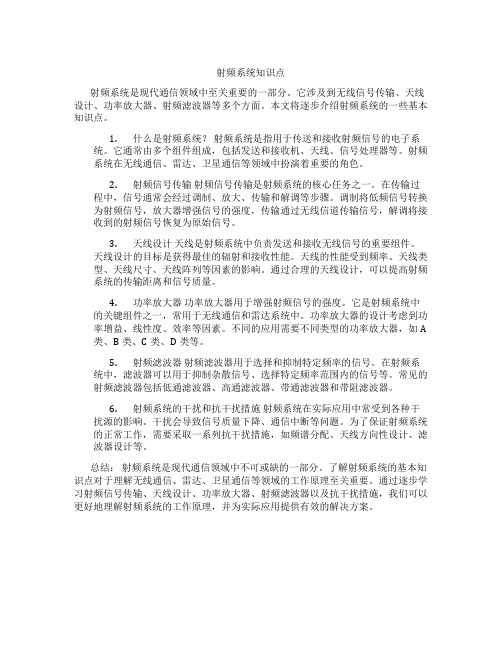
射频系统知识点射频系统是现代通信领域中至关重要的一部分。
它涉及到无线信号传输、天线设计、功率放大器、射频滤波器等多个方面。
本文将逐步介绍射频系统的一些基本知识点。
1.什么是射频系统?射频系统是指用于传送和接收射频信号的电子系统。
它通常由多个组件组成,包括发送和接收机、天线、信号处理器等。
射频系统在无线通信、雷达、卫星通信等领域中扮演着重要的角色。
2.射频信号传输射频信号传输是射频系统的核心任务之一。
在传输过程中,信号通常会经过调制、放大、传输和解调等步骤。
调制将低频信号转换为射频信号,放大器增强信号的强度,传输通过无线信道传输信号,解调将接收到的射频信号恢复为原始信号。
3.天线设计天线是射频系统中负责发送和接收无线信号的重要组件。
天线设计的目标是获得最佳的辐射和接收性能。
天线的性能受到频率、天线类型、天线尺寸、天线阵列等因素的影响。
通过合理的天线设计,可以提高射频系统的传输距离和信号质量。
4.功率放大器功率放大器用于增强射频信号的强度。
它是射频系统中的关键组件之一,常用于无线通信和雷达系统中。
功率放大器的设计考虑到功率增益、线性度、效率等因素。
不同的应用需要不同类型的功率放大器,如A 类、B类、C类、D类等。
5.射频滤波器射频滤波器用于选择和抑制特定频率的信号。
在射频系统中,滤波器可以用于抑制杂散信号、选择特定频率范围内的信号等。
常见的射频滤波器包括低通滤波器、高通滤波器、带通滤波器和带阻滤波器。
6.射频系统的干扰和抗干扰措施射频系统在实际应用中常受到各种干扰源的影响。
干扰会导致信号质量下降、通信中断等问题。
为了保证射频系统的正常工作,需要采取一系列抗干扰措施,如频谱分配、天线方向性设计、滤波器设计等。
总结:射频系统是现代通信领域中不可或缺的一部分。
了解射频系统的基本知识点对于理解无线通信、雷达、卫星通信等领域的工作原理至关重要。
通过逐步学习射频信号传输、天线设计、功率放大器、射频滤波器以及抗干扰措施,我们可以更好地理解射频系统的工作原理,并为实际应用提供有效的解决方案。
无线通信与射频技术

无线通信与射频技术随着现代科技的迅猛发展,无线通信与射频技术已经成为电子与电气工程领域中不可或缺的重要组成部分。
无线通信技术的出现和发展,使得人们可以在任何时间、任何地点进行信息的传递和交流,极大地提高了人们的生活质量和工作效率。
射频技术是无线通信的核心技术之一,它涉及到电磁波的传输和接收。
在无线通信中,射频技术被广泛应用于无线电、卫星通信、雷达、无线局域网等领域。
射频技术的主要任务是将信息转换为电磁波,并通过天线进行传输。
在接收端,射频技术将接收到的电磁波转换为可识别的信息。
射频技术的应用范围广泛,从家庭无线网络到全球卫星通信系统,都离不开射频技术的支持。
无线通信与射频技术的发展离不开电子与电气工程师的不懈努力。
电子与电气工程师在无线通信与射频技术领域的研究和应用中,扮演着重要的角色。
他们负责设计和开发无线通信系统的硬件和软件,优化系统的性能和可靠性。
他们还负责解决无线通信系统中的各种技术难题,如信号干扰、传输距离限制、频谱资源管理等。
在无线通信与射频技术领域,电子与电气工程师需要具备深厚的专业知识和技能。
他们需要了解电磁波的特性和传播规律,掌握射频电路设计和天线设计的原理和方法。
此外,他们还需要熟悉无线通信标准和协议,了解无线通信系统的工作原理和性能指标。
电子与电气工程师还需要具备良好的问题解决能力和团队合作精神,以应对日益复杂的无线通信系统和射频技术挑战。
随着科技的不断进步,无线通信与射频技术的应用前景广阔。
例如,5G技术的快速发展将为无线通信带来更高的速度和更低的延迟,为物联网、智能交通、智能制造等领域的发展提供更强大的支持。
此外,射频技术的应用也将不断拓展,如毫米波通信、无线电能传输等新兴技术的出现,将进一步推动无线通信与射频技术的发展。
总之,无线通信与射频技术在电子与电气工程领域中具有重要地位和广泛应用。
电子与电气工程师在无线通信与射频技术的研究和应用中发挥着关键作用,他们的努力和创新将不断推动无线通信技术的发展,为人们的生活和工作带来更多便利与可能性。
射频方案介绍

射频方案介绍射频(Radio Frequency)指的是无线电波在空气中传输的频段范围,是一个广泛的概念,包括许多不同的无线通信技术和应用。
在现代社会中,射频技术已经广泛应用于无线通信、广播、雷达、导航、定位和遥控等领域。
本文将对射频通信系统设计的基本原理和方法进行介绍。
1. 什么是射频通信系统射频通信系统是指利用无线电波在空气中传播的特性,实现信息传输的一种通信系统。
其基本构成包括发射机、接收机和传输介质(天线)。
其中,发射机将电信号转换成适合于天线传输的无线电信号,在空气中传播,接收机通过天线将接收到的无线电信号转换成电信号,完成信息传输。
在射频通信系统中,天线是起着重要的作用,其主要功能是将发射机产生的无线电信号转换成电磁波,在空间中传输。
2. 射频通信系统设计原理射频通信系统设计的基本原理是通过调制信号的特性来实现信息的传输。
具体来说,射频信号是在载波上调制信息的,而载波的频率和调制信号的特性决定了射频信号在空间中的传播特性。
因此,在设计射频通信系统时,需要考虑以下几个方面:2.1 载波频率和带宽载波频率是指射频信号的基础频率,而带宽则是指载波频率上下的频率范围,是一个很重要的参数。
在实际的应用中,载波频率和带宽是由多种因素共同决定的,如通信环境、传输距离、通信带宽等因素。
因此,在射频通信系统设计中,需要根据实际应用的需求来选择载波频率和带宽。
2.2 调制方式调制方式指的是把信息信号嵌入到射频信号中的方式。
调制方式的种类较多,主要包括常见的调幅(AM)、调频(FM)、调相(PM)等。
在选择调制方式时,需要考虑到传输距离、传输带宽、传输质量等因素。
2.3 天线设计天线是射频通信系统中非常重要的组成部分之一,决定了射频信号在空间中的传输特性。
在天线设计中,需要考虑到天线的增益、方向性、辐射效率等因素,以此来提高信号的传输质量。
2.4 传输介质的选择传输介质是指射频信号在空气中传输的过程中所依赖的介质,主要包括自由空间、大气、人造介质等。
- 1、下载文档前请自行甄别文档内容的完整性,平台不提供额外的编辑、内容补充、找答案等附加服务。
- 2、"仅部分预览"的文档,不可在线预览部分如存在完整性等问题,可反馈申请退款(可完整预览的文档不适用该条件!)。
- 3、如文档侵犯您的权益,请联系客服反馈,我们会尽快为您处理(人工客服工作时间:9:00-18:30)。
1.射频和无线通信系统介绍概述This tutorial is part of the National Instruments Measurement Fundamentals series. Each tutorial in this series teaches you a specific topic of common measurement applications by explaining the theory and giving practical examples. This tutorial covers an introduction to RF, wireless, and high-frequency signals and systems.本教程是测量NI基础系列的一部分。
本系列教程中的每一个指南结合理论解释和实际的例子教你常用的测量应用。
本教程介绍介绍了射频,无线和高频信号与系统。
For the complete list of tutorials, return to the NI Measurement Fundamentals Main page, or for more RF tutorials, refer to the NI RF Fundamentals Main subpage.对于教程的完整清单,请返回NI Measurement Fundamentals Main page,或更多的射频教程,请参阅NI RF Fundamentals Main subpage.目录1.Marconi and the First Wireless Transmissions 马可尼和第一次无线传输2.What is RF?射频是什么?3.Why Operate at Higher Frequencies? 为什么工作在更高的频率?4.Frequency Shifting through Frequency Mixing通过混频移频5.Looking for more RF Basics? 寻找更多的射频基础知识?6.Relevant NI Products7.Conclusions结论Marconi and the First Wireless TransmissionsRadio Frequency (RF) and wireless have been around for over a century with Alexander Popov and Sir Oliver Lodge laying the groundwork for Guglielmo Marconi’s wireless radio developments in the early 20th century. In December 1901, Marconi performed his most prominent experiment, where he successfully transmitted Morse code from Cornwall, England, to St John’s, Canada.在亚历山大波波夫爵士和奥利弗洛奇奠定了20世纪初马可尼无线电台的基础时,射频(RF)和无线已经出现了一个世纪。
在1901年12月,马可尼进行他最杰出的实验,在那里他成功从英国康沃尔发送莫尔斯码到加拿大圣约翰。
What is RF? 什么是射频?RF itself has become synonymous with wireless and high-frequency signals, describing anything from AM radio between 535 kHz and 1605 kHz to computer local area networks(LANs) at 2.4 GHz. However, RF has traditionally defined frequencies from a few kHz to roughly 1 GHz. If one considers microwave frequencies as RF, this range extends to 300 GHz. The following two tables outline the various nomenclatures for the frequency bands. The third table outlines some of the applications at each of the various frequency bands.RF本身已成为无线和高频信号的代名词,它包括了535kHz~1605kHz的调幅无线电到2.4 GHz的计算机局域网(LAN)之间的任何频率。
然而,传统定义的RF从几kHz的频率至大约1GHz。
如果把微波频率考虑作为射频,这个范围扩展到300GHz。
以下两个表概述了各频段的术语。
第三表列出了在不同频段的一些应用。
T able 1: Frequency Band DesignationsTable 1 shows a relationship between frequency (f) and wavelength (λ). A wave or sinusoid can be completely described by either its frequency or its wavelength. They are inversely proportional to each other and related to the speed of light through a particular medium. The relationship in a vacuum is shown in the following equation:where c is the speed of light. As frequency increases, wavelength decreases. For reference, a 1 GHz wave has a wavelength of roughly 1 foot, and a 100 MHz wave has a wavelength of roughly 10 feet.表1显示了频率(f)和波长(λ)的关系。
波或正弦波可以完全由其频率或波长描述。
他们成反比关系,并与通过特定媒介的光速有关。
在真空的关系如公式如下:。
其中c是光速。
随着频率的增加,波长减小。
作为参考,1 GHz的波具有波长约为1英尺,100 MHz的波有大约10英尺的波长。
T able 2: Microwave Letter Band DesignationsT able 3: Frequency Applications and Allocations in the U.S.RF measurement methodology can generally be divided into three major categories: spectral analysis, vector analysis, and network analysis. Spectrum analyzers, which provide basic measurement capabilities, are the most popular type of RF instrument in many general-purpose applications. Specifically, using a spectrum analyzer you can view power-vs-frequency information, and can sometimes demodulate analog formats, such as amplitude modulation (AM), frequency modulation (FM), and phase modulation(PM).Vector instruments include vector or real-time signal analyzers and generators. These instruments analyze and generate broadband waveforms, and capture time, frequency, phase, and power information from signals of interest. These instruments are much more powerful than spectrum analyzers and offer excellent modulation control andsignal analysis.Network analyzers, on the other hand, are typically used for making S-parameter measurements and other characterization measurements on RF or high-frequency components. Network analyzers are instruments that correlate both the generation and analysis on multiple channels but at a much higher price than spectrum analyzers andvector signal generators/analyzers.射频测量方法大致可以分为三大类:频谱分析,矢量分析和网络分析。
频谱分析仪,它提供基本的测量功能,在许多通用应用中是最受欢迎的RF仪器类型。
具体来说,使用频谱分析仪可以查看功率与频率的信息,有时可以解调模拟格式,如调幅(AM),调频(FM)和相位调制(PM)。
矢量仪器包括矢量或实时信号分析仪和发生器。
这些仪器分析和产生宽带波形,并从感兴趣的信号捕获时间,频率,相位,功率信息。
这些仪器比频谱分析仪功能强大,提供优良的调制控制和信号分析。
网络分析仪通常用于射频或高频元件的S -参数测量及其他特性的测量。
